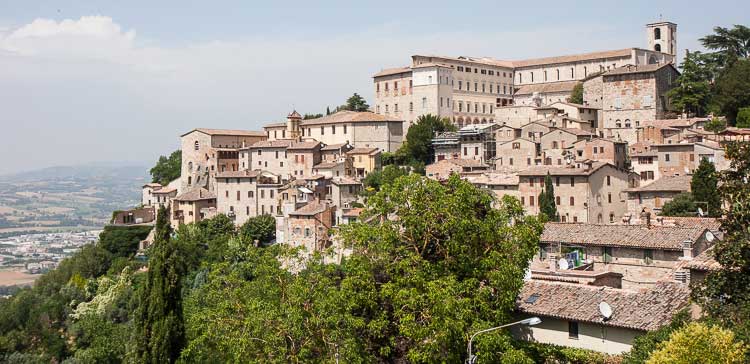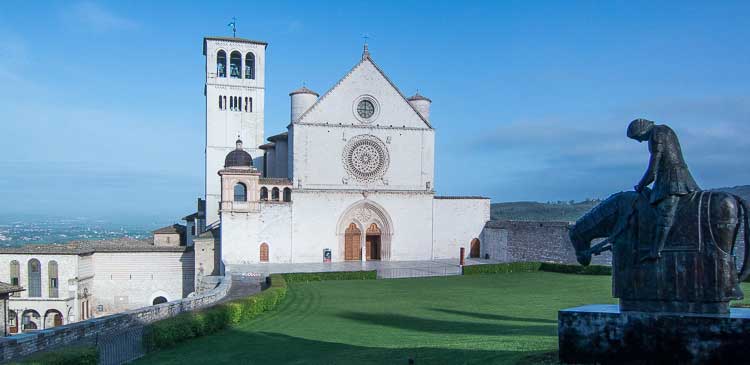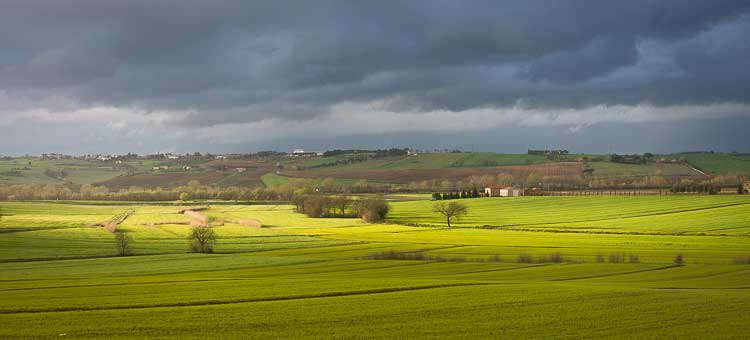You've heard it before, Umbria: Italy's green heart. Our map of the region of Umbria shows the most popular places to visit.
Why go to Umbria? It's got a great cuisine, great cities, and it's less populated than neighboring Tuscany.
Umbria inclues only two provinces: Terni and the larger Perugia province.
Table of contents
Map of Umbria: Towns and Villages to Visit

Getting Your Bearings in Umbria
A glance at the map of Umbria shows three likely east-west paths that can be incorporated into your Italian tourist itinerary. A cut across the northern section, from Tuscany to Citta di Castello to Gubbio and on to some pretty fascinating destinations in Le Marche like Fabriano or the monastery of Fonte Avellana would make a fine week to ten day itinerary. A stop in little Pascelupo for tourists looking for a place of peace perched in the Apennines in view of the 11th century hermitage of San Girolamo might be in order as well.
It is the center of Umbria that's packed with top tourist destinations, from the historically significant body of water called Lake Trasimeno to tourist favorites like Perugia, Assisi, and Spello, to smaller places like ceramics hot-spot Deruta and the walled wine and olive oil town of Torgiano. Wine aficionados looking for an experience quite different than a tasting in a large winery in the US will head for little Madrevite to the east of the lake and not far from the famous Tuscan wine towns of Montalcino and Montepulciano. See the Etruscan tomb on their property, then taste some of the wines; Glanio is fantastic. If you have an apartment, you can stock up on fine Umbrian olive oil and on an ancient dried bean reborn that you don't have to soak before cooking: Fagiolina del Trasimeno.
The southern itinerary takes you from the Etruscan towns of northern Lazio in the historical region of Tuscia (where lies the tourist favorite Civita di Bagnoregio) to dramatically perched Orvieto and on to Todi, Spoleto, and Norcia, famous for its preserved pig parts and views of Monte Sibilini National Park. On the Le Marche side you'll find the compelling destination of Ascoli Piceno.
There is no shortage of attractions in Umbria.
Main Cities of Umbria
Umbria's largest city is Perugia, a provincial capital of around 166,000 people. located in the heart of the region. It is a very interesting hill town, girded in Etruscan, Roman and Medieval walls, that tourists often miss. The piazza IV Novembre, shown below, holds the newly cleaned and restored Fontana Maggiore adjacent to the Sala dei Notari and the Duomo. The Tourist Office is here. The big street, Corso Vannucci, is the historic main street in town, taking you past the Palazzo dei Priori and other historic palazzi. At the other end of the Corso is the Piazza Italia and a good place to eat (and stay), the Albergo Ristorante La Rosetta. Other restaurants we like are Osteria Il Gufo and, near the university, Dal mi Cocco.
There's a train station in Perugia, but it's at the base of the hill. You can walk up (way up!) in about 20 minutes. The easier way is to take the bus right outside the train station or the new mini metro. The advantage of walking (or of parking your car in the underground lot in Piazza Partigiani) is that you can walk (and take escalators) through the buried Rocca Paolina, the first fortress to be build in Perugia. And...it's free. If you're already at the top, look for the escalator in the Piazza Italia to descend into the Rocca.
Perugia is host not only to the Perugia Jazz festival, but to the Universita per Straineiri, where you can take Italian language courses. We did and it was a fabulous experience.

Orvieto
Orvieto is a picturesque medieval hill town known for its stunning 14th century cathedral, specifically the mosaic facade that sparkles in the sunlight and is especially grand after a rainstorm. You can see the underground city carved out of the soft tufa or head down the slopes of the hill and see the Etruscan tombs--and get a context for them at the national Archaeological Museum which happens to be next to the Duomo Museum in Piazza del Duomo.
Todi
Todi isn't a name that comes up on many tourist itineraries, but the hill town overlooking the Tiber makes an easy and compact visit; the main monuments pretty much all front on the Piazza del Popolo, one of Italy's finest and the background for lots of movies.
Todi is the focus of a famous wine, Grechetto di Todi, which you can have with the local baccala fritto. Other things to try are the lentil soup and boar with the Umbrian red Sagrantino.
The big market day is Saturday in Todi.
Todi is 46 km from Perugia. The train from Perugia to Todi takes 32 minutes. It departs from Pretola station every four hours.

Assisi
Assisi is certainly one of the most important destinations in Umbria. Just past the edge of town is Saint Francis Basilica, where you can see the tomb of Saint Francis. Adjacent to the Basilica is the new Bosco di San Francesco, a path through a woodland dedicated to Saint Francis. At the end of the trail is the recommended Osteria il Mulino with great Umbrian cuisine. For detailed recommendations on what to see and do in Assisi, use the buttons below.
Assisi Travel Guide Lodging: Hotels and Apartments

Castiglione del Lago
Rebecca Winke, former owner and host of Brigolante Guest Apartments in Assisi, describes the lakeside town of Castiglione:
"...a postcard-perfect resort town perched on a small promontory jutting out into the lake, is one of the lake's most visited destinations. This popularity comes as no surprise, as its panoramic position above the water, dramatic Rocca del Leone fortress with walkable parapets, plethora of restaurants and shops, and languid, friendly air make it a perfect base for visiting the surrounding area or a day-trip."
Take a tour of the castle and surrounding lake and prepare to relax.

Corciano
Corciano is one of those beautiful, hill town walled villages designated as a Borghi Più Belli D'Italia. It's about half way between Perugia to Lake Trasimeno. Don't miss the Archaeological Museum, here called the Antiquarium comunale. It's all about the Etruscans and their tombs, and many of them still have the original colors painted on.
Also interesting is the Museo della civiltà contadina, a house restored and furnished with tools and goods reflecting what it would have been like in the "olden days" for a family that worked the land.
You need a car here to get the most of a visit, since most of the lodging and many of the restaurants are in the valley outside the double walls of the village.
How to Get Around Umbria Without a Car
The major cities and a surprising number of small towns are covered by Umbria's rail system, augmented by buses when necessary. We have a map of the routes and information on a new transportation pass that gets you around the entire region. Just click the button below.
Umbrian Cuisine: What to Try When You're There
Umbria has many culinary specialties, from the forementioned Fagiolina del Trasimeno on the humble side to the spaghetti or strangozzi with truffles on the luxury side. (Umbria is Italy’s largest producer of black truffles) In addition to the Trasimeno beans, you might wish to try Cannara onions and Trevi black celery. The fresh pasta in Umbria is often made without eggs.
When they're available, you hardly see an Umbrian menu that doesn't feature black truffles, either with pasta or as crostini al tartufo on an appetizer plate.
Umbria's town of Norcia is the Italian center of cured meats, so prominent that norceria is a term for a place that sells salumi anywhere in Italy. Just
Top grains and legumes include the DOP farro from Spoleto and lentils from Castelluccio as well as several kinds of broad beans.
For unique wines to try, the red Sagrantino of Montefalco is the one you should search for. Quality versions carry the DOC and DOCG versions on the label.
When to Go to Umbria
The best times to go are May though June or September through October. November and December are likely to have the most precipitation. While summer isn't particularly stiffing, the crowds do tend to ruin the atmosphere a bit. After all, you might want to attend Perugia's Umbria Jazz in July.
Perugia Weather and Historic Climate
Umbria Tours
Even if you're seeing Umbria on your own, there are times when you need things explained to you. Viator offers many walking tours of popular cities in Umbria like Assisi, Perugia and Orvieto, plus tours to smaller towns like Montefalco and Bevagna.
Country Slow Living in Central Umbria
Perhaps you'd like to take a self-catering apartment as a hub for your Umbria exploration. Perhaps you wouldn't mind a cooking class. Maybe you want to buy some olive oil from a reputable producer who is particularly enthusiastic about fine olive oil who happens to also be your host. Get thee then to Fontinaro.
If you would like a truffle tour with substance, and wish to live in luxury while surrounded by a self-sufficient village in which each landowner must be related to the original occupants in the 1400s, you might head over to The Black Truffle Lodge in the tiny village of Pettino near Trevi and Foligno. You don't even need a car; they'll pick you up at a nearby train station if you make arrangements in advance.
Have a blast in Umbria. It's one of my very favorite regions of Italy.
And by all means get out in the Umbrian countryside. It is indeed green, even in iffy weather...

Planning a Trip to Italy?
Here are some travel planning tools that are especially useful if you're planning your first or second trip to Italy.
- Travel Planning Timeline: Learn what you need to plan when.
- What Will an Italy Vacation Cost?: Tools for budgeting your Italian vacation.
- Unplanned Attractions: Save time for the good life in Italy.